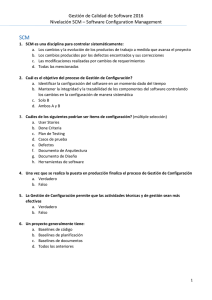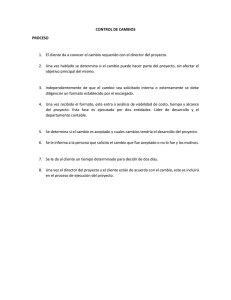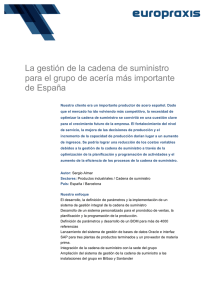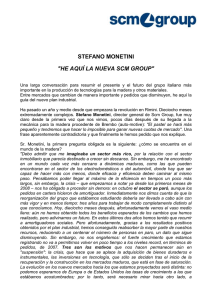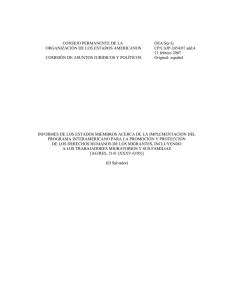Transparencias de clase
Anuncio
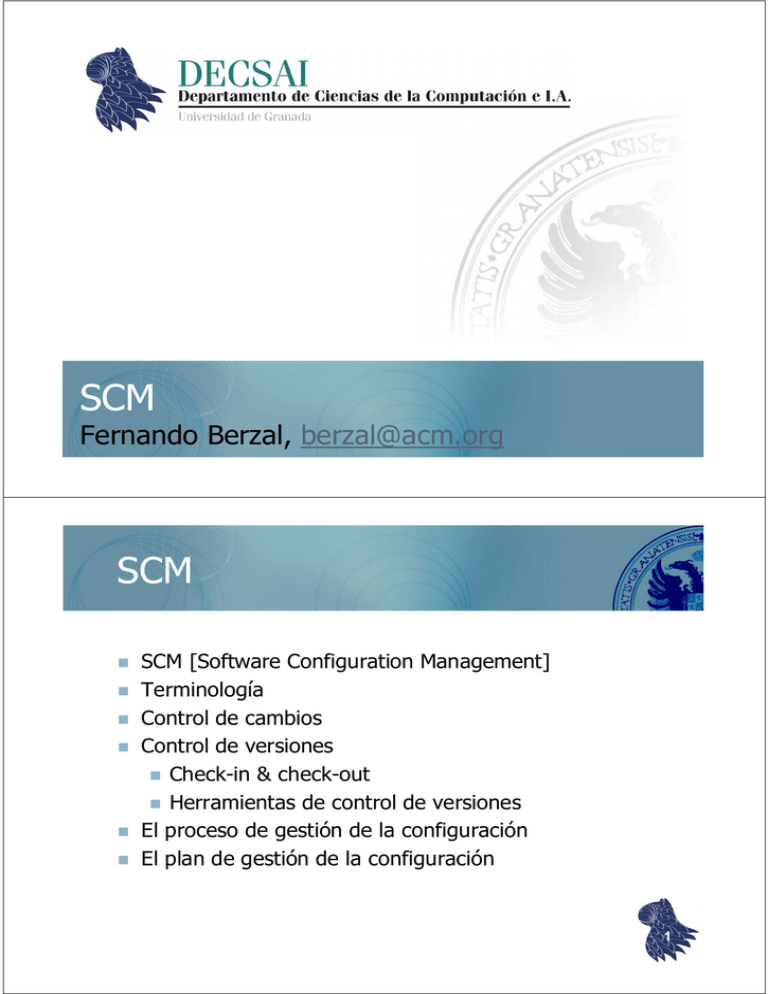
SCM Fernando Berzal, berzal@acm.org SCM SCM [Software Configuration Management] Terminología Control de cambios Control de versiones Check-in & check-out Herramientas de control de versiones El proceso de gestión de la configuración El plan de gestión de la configuración 1 SCM No matter where you are in the system life cycle, the system will change, and the desire to change it will persist throughout the life cycle. Edward H. Bersoff, Vilas D. Henderson & Stanley G. Siegel: Software Configuration Management: An Investment in Product Integrity 1980 2 SCM Software Configuration Management SCM no es sólo disponer de una herramienta que registre quién hizo qué cambio al código o a la documentación y cuándo lo hizo. SCM también incluye la creación de convenciones sobre el código, políticas y procedimientos que aseguren que todos los “stakeholders” relevantes están involucrados en la realización de cambios sobre el software: Conjunto de actividades realizadas para gestionar los cambios a lo largo del ciclo de vida del software. 3 SCM Cómo informar de un problema con el software. Cómo solicitar la incorporación de un nuevo requisito. Cómo informar de los cambios solicitados y pedir sus opiniones a los “stakeholders” involucrados. Cómo priorizar y planificar las solicitudes de cambios. Cómo mantener bajo control las distintas versiones de los productos (i.e. impedir que puedan cambiarse sin seguir los procedimientos apropiados). 4 SCM Área de proceso clave [KPA] en el nivel 2 del modelo SW-CMM [SEI Capability Maturity Model for Software]. 5 SCM Propósito Mantener la integridad de los productos de un proyecto de desarrollo de software a lo largo de su ciclo de vida. 6 SCM Aborda 4 tipos de problemas habituales: Comunicación (el número de vías de comunicación aumenta cuadráticamente con el tamaño del equipo). Cambios (problemas cuando un programador no es consciente de los últimos cambios realizados sobre un ítem compartido). Actualizaciones (problemas asociados a la actualización simultánea de ítems compartidos). Mantenimiento (problemas asociados al mantenimiento de múltiples versiones). 7 SCM Beneficios Se evitan problemas asociados a la realización de cambios y se facilitan las tareas de mantenimiento. Aumento de productividad (disminución de trabajo repetido [rework]). Automatización de tareas, p.ej. Seguimiento de defectos [defect logging & tracking]. 8 Terminología SCI [Software Configuration Item]: Unidad fundamental en un sistema de gestión de la configuración, p.ej. ficheros de código, planes, modelos, especificaciones, documentos, procesos… 9 Terminología Versión Versión específica de un SCI v1.0 Cambios (diff o delta) v2.0 10 Terminología Configuración Colección de versiones concretas de ítems SCI. 11 Terminología Baseline [“línea base”]: Versión aprobada de un producto en un momento determinado que sirve de base para definir cambios. modified SCIs Project database Software engineering tasks SCIs Formal technical reviews approved SCIs stored SCIs extracted SCM controls SCIs BASELINES : System Specification Software Requirements Design Specification Source Code Test Plans/Procedures/Data Operational System 12 Roger S. Pressman: “Software Engineering: A Practitioner’s Approach” 7/e Terminología Release Distribución formal de una versión aprobada. p.ej. al equipo de QA, versión alfa/beta, versión para un cliente determinado, RTM [release to manufacturing]… 13 https://en.wikipedia.org/wiki/Software_release_life_cycle Terminología Branch [“rama”] Duplicación de un conjunto de SCI’s de forma que las modificaciones puedan realizarse en paralelo. “trunk” (línea de desarrollo que no es una rama), a.k.a. baseline, mainline o master. Conjunto de ramas de un proyecto: árboles de versiones [trees], streams o “codelines” 14 Terminología Eran Gery & Joanne L. Scouler: “Strategic reuse and product line engineering.” IBM developerWorks, October 2014 http://www.ibm.com/developerworks/rational/library/14/strategic-reuse/strategic-reuse-pdf.pdf 15 Control de cambios Micro Focus StarTeam 16 Control de cambios “Software is never done”… CR [Change Requests] Change “triage” CCB [Change/Configuration Control Board] p.ej. informal en proyectos pequeños 7 niveles en FAA NAS [National Airspace System] 17 Control de cambios Programmer Master Promotion Directory Release Software Repository User Tipos de cambios: Promotion (interno a la organización de desarrollo) Release (visible fuera de la organización de desarrollo) 18 Control de cambios Programmer’s directory [IEEE Std.: “dynamic library”], bajo el control del programador. Master directory [IEEE Std.: “controlled library”] contiene la línea base actual, sólo con los cambios autorizados. Promotion Central source code archive Release Software repository [IEEE Std.: “static library”], Foo’95 archivo de las versiones publicadas. Foo’98 19 Control de versiones El almacén (a.k.a. repositorio) SCM proporciona el conjunto de mecanismos y estructuras de datos que permiten gestionar los cambios de forma efectiva. Funciones Integridad de las distintas versiones. Gestión de dependencias entre elementos SCI. Compartir datos entre los miembros del equipo. Integración con las herramientas de desarrollo. Aplicación de mecanismos de gestión de cambios (p.ej. aprobación en revisiones técnicas formales). Trazabilidad (p.ej. Requisitos). Realización de auditorias 20 Control de versiones Un sistema de control de versiones implementa o se integra directamente con: Una base de datos (o repositorio) del proyecto. Una herramienta de gestión de versiones que maneja todas las versiones de cada SCI. Una herramienta de compilación [make/build] que permite automatizar la creación de versiones específicas. Una herramienta de seguimiento [issue/bug tracking] que permite registrar y controlar todos los hechos o problemas asociados a los distintos SCI. 21 Control de versiones Contenido de la base de datos del proyecto use-cases analy sis model business rules business funct ions organizat ion st ruct ure informat ion archit ect ure Business Cont ent scenario-based diagrams flow-orient ed diagrams class-based diagrams behavioral diagrams design model archit ect ural diagrams int erface diagrams component -lev el diagrams source code object code sy st em build inst ruct ions Const ruct ion Cont ent t echnical met rics t est cases t est script s t est result s qualit y met rics Model Cont ent V&V Cont ent project est imat es project schedule Project Management Cont ent SCM requirement s change request s change report s SQA requirement s project report s/ audit report s project met rics Document s Project Plan SCM/ SQA Plan Syst em Spec Requirement s Spec Design Document Test Plan and Procedure Support document s User manual 22 Roger S. Pressman: “Software Engineering: A Practitioner’s Approach” 7/e Control de versiones Check-in & check-out http://betterexplained.com/articles/a-visual-guide-to-version-control/ 23 Control de versiones Lista de comprobación para la realización de check-ins Check-in Meeting Checklist Describe the changes in the check-in Bug numbers fixed? Files and databases changed? Developer's confidence level Developer's assessment of risks in the code / what most concerned about? Known issues remaining? Any areas of code more brittle than others? Is the code documented? Is the code testable? Has the developer tested it? Who code-reviewed prior to check-in? (right choice of reviewer?) Possible performance issues? Any hidden secrets to how it really works? Projected impacts on other programmers' work? Requests/notes to QA? Notes to Documentation Team? Notes to Build Team? 24 Control de versiones What makes a good developer a great developer is willingness to take risks. You can measure a developer's willingness to take risks by the frequency they check into source control. Source control is their safety net. -- Ike Ellis: “Continuous Integration”, Silicon Valley Code Camp 2013 25 Control de versiones Herramientas de control de versiones Sistemas locales (usuarios únicos) SCCS [Source Code Control System], Mark Rochkind, Bell Labs, 1972 RCS [Revision Control System], Walter F. Tichy, Purdue University, 1982 PVCS [Polytron Version Control System] Serena Software, 1985 26 Control de versiones Herramientas de control de versiones Sistemas cliente/servidor CVS [Concurrent Versioning System], Dick Grune, VU University Amsterdam,1986 Subversion a.k.a. SVN CollabNet, 2000-2004 (proyecto Apache desde 2010) Herramientas comerciales: Rational ClearCase (1992), Perforce (1995), StarTeam (1995), Surround SCM (2002), AccuRev SCM (2002), Microsoft Team Foundation Server (2005)… 27 Control de versiones Subversion Global revision number 28 Control de versiones Subversion Branching (copia) editor 3 editor 4 editor 6 svn copy editor myEditor myEditor 5 29 Control de versiones Subversion 30 Control de versiones Herramientas de control de versiones Sistemas distribuidos GNU arch Thomas Lord, 2001 Git Linus Torvalds et al., 2005 (Linux kernel) Mercurial a.k.a. hg Matt Mackall, 2005 (Python) Herramientas comerciales: Code Co-op (1997), BitKeeper (1998), Plastic SCM (2006)… 31 Control de versiones De Subversion (C/S) a Git (P2P) https://www.atlassian.com/git/tutorials/ 32 Control de versiones Git Branching & merging https://illustrated-git.readthedocs.org/en/latest/ 33 Control de versiones Git Remote repositories https://illustrated-git.readthedocs.org/en/latest/ 34 Control de versiones Mercurial 35 El proceso SCM Software Vm.n reporting configuration auditing version control change control identification SCIs 36 Roger S. Pressman: “Software Engineering: A Practitioner’s Approach” 7/e Plan SCM Generalmente, las decisiones acerca de cómo resolver las cuestiones de SCM se recopilan en un documento: SCMP Software Configuration Management Plan Este documento se elabora al comienzo del proyecto y, normalmente, se aprueba más o menos cuando se aprueba la especificación de requisitos del sistema. 37 Plan SCM Estándar IEEE 828-2005 Software Configuration Management Plan 1. 2. 3. Introduction (describes the plan’s purpose, scope of application, key terms, and references) SCM management (WHO?) (identifies the responsibilities and authorities for the planned SCM activities) SCM activities (WHAT?) (identifies all activities to be performed) 38 Plan SCM Estándar IEEE 828-2005 Software Configuration Management Plan 4. 5. 6. SCM schedule (WHEN?) (establishes required coordination of SCM activities with other activities in the project) SCM resources (HOW?) (identifies tools and physical and human resources required for the execution of the Plan) SCM plan maintenance (identifies how the Plan will be kept current while in effect) 39 Plan SCM SCMP Section 3: SCM activities 3.1 Configuration identification (identification, naming conventions & acquisition) 3.2. Configuration control (request, evaluation, approval & implementation) 3.3. Configuration status accounting (metrics to be tracked and reported) 3.4. Configuration evaluation and reviews (audit on CI before release: objective, schedule, procedures, participants, approval criteria…) 40 Plan SCM SCMP Section 3: SCM activities 3.5. Interface control (coordination of changes to CIs with changes to interfacing items outside of the scope of the Plan) 3.6. Subcontractor/vendor control (incorporation of items developed outside the project environment into the project CIs) 3.7. Release Management and Delivery (description of the formal control of build, release and delivery of software products) 41 Plan SCM SCMP following the IEEE 828-2005 standard Define configuration items Define promote / release policies Define activities and responsibilities Set up configuration management system 42 Comentarios finales “The success of SCM is not primarily determined by tool sophistication, but by the attitude and cooperation of the people involved.” -- Alexis Leon: “A Guide to Software Configuration Management” EJEMPLO Check-ins limitados al final del proyecto: Sólo para actualizaciones críticas 43 Bibliografía Libros de texto Roger S. Pressman: Software Engineering: A Practitioner’s Approach McGraw-Hill, 8th edition, 2014. ISBN 0078022126 Shari Lawrence Pfleeger & Hoanne M. Atlee: Software Engineering: Theory and Practice Prentice Hall, 4th edition, 2009. ISBN 0136061699 Ian Sommerville: Software Engineering Pearson, 10th edition, 2015. ISBN 0133943038 44 Bibliografía Lecturas recomendadas Dwayne Phillips: The Software Project Manager's Handbook: Principles That Work at Work Wiley / IEEE Computer Society, 2nd edition, 2004 ISBN 0471674206 Donald J. Reifer (editor): Software Management Wiley / IEEE Computer Society, 7th edition, 2006 ISBN 0471775622 Richard H. Thayer (editor): Software Engineering Project Management Wiley / IEEE Computer Society, 2nd edition, 2000 ISBN 0818680008 45 Bibliografía complementaria SCM Stephen P. Berczuk & Brad Appleton: Software Configuration Management Patterns: Effective Teamwork, Practical Integration Addison-Wesley Professional, 2002. ISBN 0201741172 Alexis Leon: A Guide to Software Configuration Management Artech House, 2000. ISBN 1580530729 Edward H. Bersoff, Vilas D. Henderson & Stanley G. Siegel: Software Configuration Management: An Investment in Product Integrity Prentice-Hall, 1980. ISBN 0138217696 46 Bibliografía complementaria Estándares IEEE 828-2012 IEEE Standard for Configuration Management in Systems and Software Engineering DOI: 10.1109/IEEESTD.2012.6170935 (Software Configuration Management Plans) ANSI/IEEE 1042-1987 IEEE Guide to Software Configuration Management DOI: 10.1109/IEEESTD.1988.94582 (practices compatible with ANSI/IEEE Std 828-1983). 47 Bibliografía complementaria Clásicos Frederick P. Brooks, Jr.: The Mythical Man-Month: Essays on Software Engineering Addison-Wesley, 1995. ISBN 0201835959 Alan M. Davis: 201 Principles of Software Development McGraw-Hill, 1995. ISBN 0070158401 Barry W. Boehm: Software Engineering Economics Prentice-Hall PTR, 1991. ISBN 0138221227 Manager's Handbook for Software Development NASA Software Engineering Laboratory, SEL-84-101, rev.1, 1990. Software Engineering Laboratory (SEL) Relationships, Models, and Management Rules 48 NASA Software Engineering Laboratory, SEL-91-001, 1991. Bibliografía Bibliografía en castellano Roger S. Pressman: Ingeniería de Software: Un enfoque práctico McGraw-Hill, 7ª edición, 2010. ISBN 6071503140 Ian Sommerville: Ingeniería de Software Pearson, 9ª edición, 2012. ISBN 6073206038 49 Ejercicios Buscar información sobre herramientas concretas que faciliten la realización de las siguientes tareas: Control de versiones Compilación [daily builds] Integración continua Pruebas automatizadas (de unidad y de aceptación) Seguimiento de defectos [bug tracking] Para cada categoría, identifique al menos 5 herramientas que se utilicen actualmente. 50
